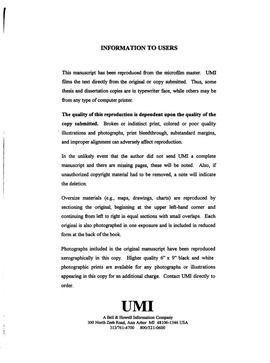| dc.contributor.advisor | Hutchison, Victor H., | en_US |
| dc.contributor.author | Lutterschmidt, William Isaac. | en_US |
| dc.date.accessioned | 2013-08-16T12:29:54Z | |
| dc.date.available | 2013-08-16T12:29:54Z | |
| dc.date.issued | 1997 | en_US |
| dc.identifier.uri | https://hdl.handle.net/11244/5569 | |
| dc.description.abstract | An organism's distribution and geographic range result from physiological tolerances and its ability to adjust physiological processes to maximize survival, growth, and reproduction under a diversity of environmental factors characteristic to its geographic region. This principle has been described by Liebig's Law of the Minimum which states that the distribution of species is governed by the environmental factor for which a species has the narrowest tolerance range or least adaptability. As described, physiological ecologists agree that temperature is probably one of the most pervasive factors in determining the distribution of animals. In this work, I address the importance of species specific thermal tolerance in an attempt to explain some macroecological patterns of distribution among fishes. The first two chapters are an evaluation and review of thermal tolerance in studies of comparative physiology. I measured the critical thermal maximum (CTMax) for more than 600 individuals to statistically evaluate the variability associated with the end points loss of righting response (LRR) and onset of spasms (OS) used in determining CTMax. In my review of thermal tolerance, I found 388 of 725 papers to provide data for a historical and taxonomic review with a discussion of various methodologies and uses for the measure of species specific thermal tolerance. | en_US |
| dc.description.abstract | In the third chapter, I investigated the correlates between the comparative physiology of thermal tolerance and macroecological patterns of distribution for several fishes found in Oklahoma. Although temperature and the physiological tolerance for changing thermal regimes are major limiting factors affecting species distribution, studies of macroecology have not adequately addressed the relationship between temperature and an organism's geographic distribution. Studies of macroecology often fail to investigate the underlying physiological factors and tolerances that influence animal distribution. This is one of the first attempts to use a "true" physiological parameter in macroecology. | en_US |
| dc.description.abstract | "Temperature and moisture are the two master limiting factors to the distribution of life on earth" (Krebs 1994). Ecologists have dedicated much study to the understanding of these factors and how they influence species and their biogeography. Organisms have four options in dealing with the climatic condition of their habitats: (1) tolerate the temperature and humidity regardless of possible consequences to fitness, (2) move to more suitable climatic conditions, (3) death, or (4) escape fitness limiting conditions through evolutionary adaptation. It is this forth option which has been one of the primary interests to comparative physiologists and physiological ecologists in explaining (1) how physiological processes function with respect to the environment, (2) how the physiological capacities of an organism enable it to live in conditions not suitable for other species, and (3) how the environment may "fine-tune" or even directionally select for particular physiological processes increasing the relative fitness of future generations. | en_US |
| dc.format.extent | xvi, 133 leaves : | en_US |
| dc.subject | Vertebrates Geographical distribution. | en_US |
| dc.subject | Vertebrates Phylogeny. | en_US |
| dc.subject | Vertebrates Effect of temperature on. | en_US |
| dc.subject | Biology, Animal Physiology. | en_US |
| dc.subject | Biology, Ecology. | en_US |
| dc.title | Comparative physiology and macroecology of thermal tolerance in ectothermic vertebrates with correlates of phylogeny and biogeography. | en_US |
| dc.type | Thesis | en_US |
| dc.thesis.degree | Ph.D. | en_US |
| dc.thesis.degreeDiscipline | Department of Biology | en_US |
| dc.note | Source: Dissertation Abstracts International, Volume: 58-10, Section: B, page: 5222. | en_US |
| dc.note | Adviser: Victor H. Hutchison. | en_US |
| ou.identifier | (UMI)AAI9812258 | en_US |
| ou.group | College of Arts and Sciences::Department of Biology | |
